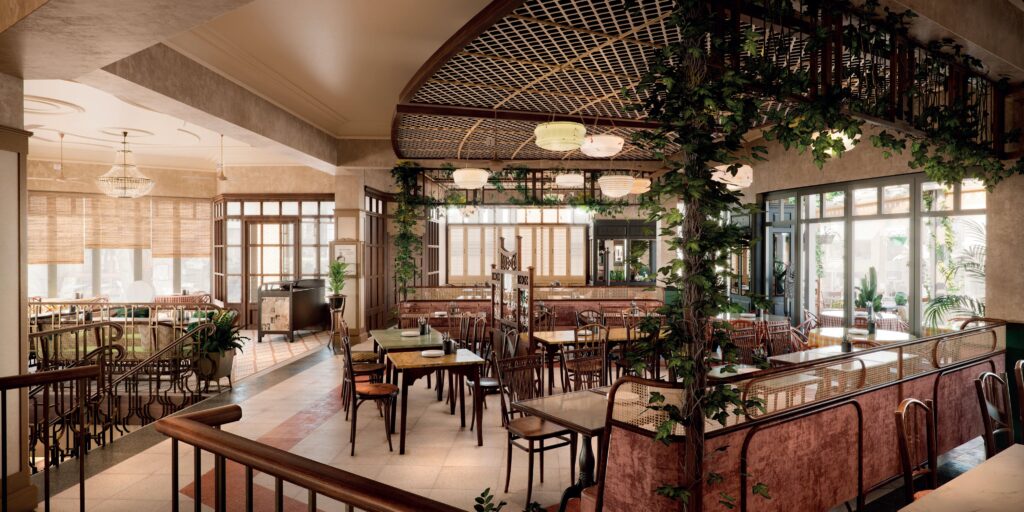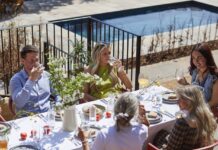Dishoom Covent Garden, the team’s very first restaurant, opened in July 2010, and was their first attempt to capture the wistful poetry of the Irani cafés of Bombay, drawing inspiration from beloved Bombay institutions such as Britannia & Co., Olympia Coffee House and Kyani & Co. The restaurant closed in January 2020 to undergo a major redesign to mark the café’s 10th anniversary. The team are delighted to announce that the new restaurant will now reopen at its old home on Upper St Martin’s Lane later this year. The café will pay loving homage to its Irani café heritage, whilst also bringing to life the stories of Bombay’s theatres, which were reincarnated in the 1940s as all-singing, all-dancing talkie houses.
Each Dishoom is a love-letter to Bombay – a way of sharing the team’s love of the city’s culture, heritage and people. Every Dishoom restaurant has its own unique story – a sort of founding myth. Imagining each new space as an Irani café rooted in some specific seam of Bombay history, this myth is something of a whimsical riff, bringing together stories of proprietors and patrons both real and imagined. This myth explores the connections between Bombay and the neighbourhood in which the café will take shape, and informs all aspect of the café’s design (no detail too small), weaving together both fact and fiction in unexpected and hopefully fun and charming ways.

Inspired by Covent Garden’s rich heritage as a landmark for theatre, cinema and the performing arts, “New” Dishoom Covent Garden will tell the story of Bombay’s theatrical journey from Parsi theatre, to silent film, to the thrill and amazement of the Talkies era. In the 1930s and 1940s many of Bombay’s foremost theatres were reincarnated as state-of-the-art cinemas, adopting fresh monikers to denote their modernity – popular theatres were reborn as “New” Empire and “New” Excelsior. Dishoom Covent Garden’s story and design will draw on this heritage.
The café’s new founding myth transports us to an age of rapid evolution and reinvention. In the ‘30s and ‘40s, cinema became a reflection of, and a catalyst for, the exhilarating transformations of the age. The advent of film heralded a wave of female liberation, with the arrival on screen of bold, outspoken and feisty heroines. Audiences were introduced to actresses with a different kind of edge – women who swung from chandeliers, jumped off cliffs and fought atop speeding trains. The early Bombay Talkies were a thrilling and novel experience, representing a world of modernity, glamour and freedom. Exuberant, emotional filmi music began to define the sound of the era. Cinema introduced Bombay to an intoxicating world of adventure and liberty.

Last year, the Dishoom team, along with their long-term design partners, Macaulay Sinclair, made their customary sojourns to Bombay, immersing themselves in the architecture, history and stories of the city’s early cinemas. They visited the finest talkie houses, including Aurora, Edward Theatre, New Empire Cinema and Palace Talkies. Many of these buildings began life as theatres, and some, such as Aurora and Palace Talkies, are, to this day, showing screenings in auditoriums that now express a faded elegance and a grandeur that is much age-worn. As spaces that evolved over many decades, Bombay’s early cinemas offer eclectic design references, bearing the imprint of numerous owners and the influences of many ages and aesthetic movements. Art Deco flourished in Bombay in the ‘40s and its influence can be found throughout the cinemas of the same era, yet these spaces were also layered with history and the design remnants of earlier epochs.
As such, at the new Dishoom Covent Garden, Deco grandeur meets with the relaxed elegance of earlier influences, including the Beaux Arts style, characterised by a decorative and ornamental aesthetic. The team were also inspired by visits to The Willingdon Club, Bombay Yacht Club and numerous private residences, which expressed an understated glamour typical of the era – painted shutters, cane and rattan furniture, and light, airy verandah spaces sit alongside elevated detailing, including decorative ceilings and ornate chandeliers. As always, the team frequented many remaining Irani cafés, met with the owners, and spent much time sourcing furniture and artefacts from the Bombay of the era.

Dishoom Covent Garden will bring together these stories to create a new-and-improved café from which to serve Dishoom’s much-loved menu of Bombay comfort food and award-winning tipples. The café has also undergone significant expansion as part of the redesign, making it a first-rate flagship restaurant for the Dishoom team. The café will reopen at its old home at 12 Upper Saint Martin’s Lane, part of The Yards, the series of newly redeveloped, interconnecting courtyards and streets including St Martin’s Courtyard and Mercer Walk. The restaurant will soon be open daily, providing patrons with everything from breakfast and mid-morning chai, to lunch and afternoon tipples, right through to evening feasts and late-night snacks, served across both floors of the café, and in the restaurant’s Permit Room bar.

Publisher of Hospitality and Leisure News, 365 Retail, Retail Source and organiser of the Creative Retail Awards.









